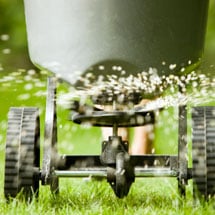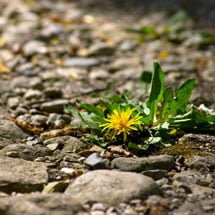What’s there not to like about an organic lawn? It’s relatively cheap. It’s better for the environment and it takes less work than your traditional well-manicured turf.
Americans take their lawns seriously. Lawns used to be for the wealthy who hired a staff to maintain the grounds of their estates. Now they are for everyone. The great equalizer was the invention of the push mower in the 1870’s by Elwood McGuire of Richmond, Indiana. (Before that, a common and labor-intensive way to trim lawns was to use scythes.) Today, U.S. homeowners spend more than $17 billion on outdoor home improvements, including lawn care.
While many of us spend a lot to get our grass mowed, fertilized and sprayed with chemicals to deter weeds and troublesome insects, it doesn’t have to be so.
The good news is that going organic makes good sense when it comes to lawn care. It takes less effort and makes for a lawn that’s safer for you, your family and your pets.

PEACE OF MIND
ORGANIC LAWN CARE
Here’s all the products and tools you need to keep your yard healthy and beautiful.
View allBest reasons for organic lawn care? Your children, your pets, you! Chemical-free landscapes give you the peace-of-mind that comes from providing your family a healthy place for outdoor play and gathering.
It’s the Height, Not the Mowing
One of the major principles behind organic lawn care is the height of your grass. Higher is better. Many homeowners mistakenly believe that they must keep their lawns mowed as low to the ground as possible to keep the grass healthy, to keep away weeds and to lengthen the time between mowings. It’s the crew-cut approach to lawn care.
The actual opposite is true. Tall blades of grass have more surface area exposed to the sun, which enables them to photosynthesize more sugars and starches for root growth. The healthier your grass roots are, the more water and nutrients they can absorb, which, in turn, makes for healthier grass blades. Keeping your grass higher works as well or better than herbicides at suppressing crabgrass, according to research done at the University of Maryland. (It may also curb low-growing weeds like dandelions or common purslane since the taller grass will starve them of sunshine.)
To achieving towering blades of grass, set your mower to its maximum, which means it will cut at 2.5 to 3 inches. Also keep your mower’s blade sharp, which will make for a clean cut and will avoid tearing or otherwise damaging the blades of grass as they are mowed. Finally, avoid mowing wet grass since that can also damage your lawn.
Another way to keep your lawn healthy and low-maintenance is to keep grass clippings on the lawn after you mow. Decomposing clippings add nitrogen, a major nutrient for grass, to the soil (see our article on Grasscycling to learn more). Many homeowners worry that keeping grass clippings will lead to thatch, dying grass parts that form a matted layer, which keeps moisture and oxygen from reaching grass roots. Thatch won’t form from cut grass. Instead, the clippings will attract earthworms, which break down thatch.
What does cause thatch? Too much fertilizer. To remove it, use a hard-tined rake to scrape the thatch out. Then, spread a layer of compost on top of the soil. The compost will encourage earthworms to come and break down the thatch as quickly as it can be formed. Learn more about controlling lawn thatch here.
Another way to keep your lawn healthy and to discourage weeds is to cast grass seeds on your lawn in the spring and fall. Be sure to reseed bald spots and tamp down the seeds. Using your feet to push the seeds into the soil is fine. You don’t need a special tool. After you’ve scattered grass seed on the lawn, be sure to water it to encourage the seeds to sprout.

HOSES, NOZZLES & SPRINKLERS
Watering Equipment
Make every drop count with our reliable watering tools, hoses and rain barrels.
View allWhen Mother Nature doesn’t deliver, your garden doesn’t have to suffer. We’ve got backup watering equipment and tools that will keep your garden from going thirsty. Let’s grow together!
When to Water?
Organic lawn care is really for the rest of us – the majority of folks who just don’t have the time to spend hours upon hours caring and cultivating our lawns.
When you take the organic “lazy man” approach, you don’t water frequently. Less is best. That doesn’t necessarily mean less water, but fewer times and for a longer duration. This helps your grass. Infrequent watering forces the grass roots to go deep into the soil – deeper than most weed roots will go, which is bad news for weeds. In addition, shallow, frequent watering promotes thatch, which you certainly don’t want to foster.
Another tip on water is to water early in the day. Waiting until the evening can cause insufficient evaporation which can lead to fungal growth.
The Depths Soil Goes To
Another way to ensure a healthy lawn is to have your soil professionally tested. Call your local agriculture extension officer, who will test for free or for a small fee. That way you’ll know exactly what type of soil you have and what it needs to keep your grass growing and prevent weeds. At Planet Natural we offer a simple, yet accurate soil test kit that uses a “color comparator” and capsule system for under $15.00.
For example, if you are topsoil poor, invest in some top soil which will lessen your work down the road. You’ll also know if you need to fertilize and with what type of fertilizer to use as well as what’s the best type of grass to grow given your soil.
Also add compost to your lawn. It will make your grass healthier. Aim to add compost once or twice a year. Do it sometime between June and August.
Fiddling with Fertilizer
Once you’ve tested the composition of your soil, you’ll know what type of fertilizer it may need. Of course you’ll want natural fertilizer. It’s best to apply it in the spring and fall. Organic lawn fertilizers, although they cost more up front, are cost-effective in the long term because they promote better growing conditions, decrease the need for pest controls and require fewer applications.

SAFE FOR PETS!
Lawn Fertilizers
Safe for people and pets! These slow release fertilizers promote lush, green turf.
View allSlow release, organic lawn fertilizers benefit your soil while providing nutrients for your grass. Not only do they improve soil structure, they encourage beneficial soil microbes that attack pests and diseases. Used in combination with good maintenance practices they will make your lawn less labor and water intensive.
In addition to fertilizer, consider feeding your lawn seaweed extract. It contains trace elements like iron, magnesium and zinc oxide. Seaweed will support plant health, root development and will help fight fungi.
Tip: Packaged in a convenient ready-to-spray bottle, Dr. Earth® Liquid Lawn Food treats an average yard size in about 15 minutes. Just attach to any garden hose and spray over your lawn. Best of all, it’s effective on all grass varieties, including fescue, bluegrass, ryegrass, St. Augustine and Bermuda grass.
To Rake or Aerate?
Remove thatch in the spring or early summer using a rake or a tool especially designed to remove that matted, dead grass.
Aeration can also promote a healthy lawn. It removes plugs of dirt which helps increase the soil’s ability to retain water and it increases air circulation to the roots. Aeration is usually a task for spring, but you can also do it in the fall. You can rent a motorized aerator from a garden center or you can purchase a pair of Lawn Aerator Sandals, which takes more work.
Curing Common Lawn Problems
Here’s a sampling of common lawn problems and organic and natural ways to solve them.
Yellow grass can be caused by traffic, lack of water or can indicate a soil deficiency (iron or nitrogen). Test your soil to determine what and whether organic soil amendments can help return your lawn to its green glory.
Bare or rough spots can also be caused by traffic or dog poop. The cure is to remove the cause. (Don’t allow pets or your family to walk on the problem areas and clean up after your dog immediately after he or she does its business or start walking Fido elsewhere.)
If you’ve eliminated the common culprits and are still having problems, see whether caterpillars are doing the damage. Most caterpillars in lawns are the larval form of a few moths species (armyworm, sod webworm). When populations are high they can chew grass down to the crown, leaving rough patches or bare spots. To get rid of these pests, rake out any thatch, apply a solution of beneficial nematodes and scatter endophyte-enhanced grass seeds on the affected area.
Brown grass is unsightly, but may not signal a major emergency. It’s often the result of poor maintenance. Be sure that you are not mowing your lawn too short and that you are watering enough. If that doesn’t do the trick, test your soil to see if it is suffering from any nutrient deficiencies and correct those deficiencies.

Weed & Pest Control
The good news is that improving lawn health by proper watering, mowing and fertilizing will greatly reduce weeds. If weeds are fairly minor (rather than overtaking the grass) start by simply weeding by hand.
Still got weeds? Part of the solution is figuring out what’s making weeds possible and changing things around so that weeds will face a tougher time. Here’s a quick tutorial on ways to keep weeds and troublesome insects at bay:

WORKS FAST!
Organic Weed Killers
We offer plenty of effective, all-natural weed-eliminating options that are safe to use.
View allAt Planet Natural we offer plenty of effective organic weed killers that are safe to use around your children, pets, and vegetables – and won’t build up in your soil. We’ve got the safest tools to keep everything under control.
If clover is taking over your lawn, there’s a good chance your soil lacks nitrates which encourages grass growth. In fact the easiest way to control clover is to promote healthy grass. To remove clover, first till the soil and then add compost to increase the soil’s fertility. Finish off by reseeding bare spots with grass. To prevent clover, apply a slow-release organic lawn fertilizer in the fall and leave clippings on the grass during the summer.
To rid your lawn of dandelions, remove the flower heads before they go to seed. Dig out the roots with a dandelion weeder. To prevent existing weed seeds from germinating, apply corn-gluten meal in early spring.
Mow your grass too low and you’ll be doing crabgrass a favor. The low grass allows sun to reach the weed’s seeds. To eradicate, completely remove plants before they go to seed and then sow grass seed. You can prevent crabgrass by allowing your lawn to stand tall at three inches. You’ll need to keep removing weeds from the reseeded spots to allow the new grass to become established.
Control bugs by mixing dishwater soap – a “natural” brand like Bi-O-kleen works best – with water.
Dirt mounds are usually caused by moles and the tunnels they burrow. Press down the mole ridges with a rake or other garden implement so that the grass roots can re engage with the soil. Then tackle the moles. The best way to keep them away is to be an inhospitable host: eliminate their food source. Moles normally invade a lawn to feed on grubs and earthworms. In the case of grubs – which can also cause brown grass – apply milky spore, the #1 control of Japanese beetle grubs.











